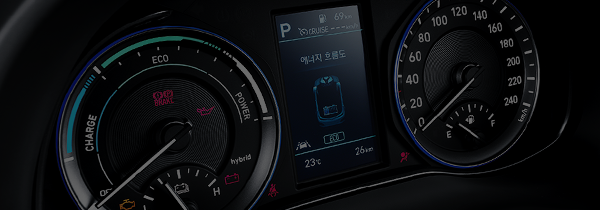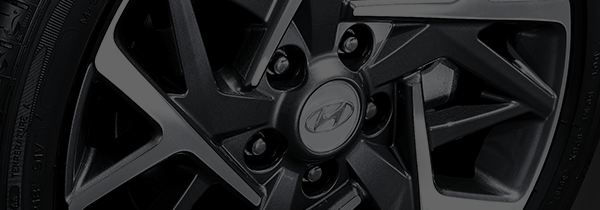
KONA Hybrid
The pleasant of KONA to KONA Hybrid
KONA Hybrid

* The figure in parentheses includes the roof rack.
| Classification | Gasoline 1.6 HEV |
|---|---|
| Overall length (mm) | 4,165 |
| Overall width (mm) | 1,800 |
| Overall height (mm) | 1,550(1,565) |
| Wheelbase (mm) | 2,600 |
| Wheel Tread, Front (mm) | 1,576 (16") / 1,565 (18") |
| Wheel Tread, Rear (mm) | 1,589 (16") / 1,577 (18") |
| Engine type | 1.6 GDi HEV |
| Displacement (cc) | 1,580 |
| Max power (PS/rpm) | 105 / 5,700 |
| Max torque (kgf·m / rpm) | 15.0 / 4,000 |
| Fuel tank capacity (ℓ) | 38 |
| Motor type | Permanent Magnet Synchronous Motor (PMSM) |
| Max. motor power (kW) | 32 |
| Max. motor torque (Nm) | 170 |
| Max. system output (PS/rpm) | 141 / 5,700 |
| Government-certified Standard Fuel Efficiency and Class | |
|---|---|
| Gasoline 1.6 HEV_6DCT(16″Tire) | Government-Declared Fuel Efficiency - Combined 19.3km/ℓ (City : 20.1km/ℓ, Highway : 18.4km/ℓ) CO2 Emissions : 82g/km | Displacement : 1,580cc | Empty Vehicle Weight : 1,395kg | 6DCT(class 1) |
| Gasoline 1.6 HEV_6DCT(18″Tire) | Government-Declared Fuel Efficiency - Combined 17.4km/ℓ (City : 18.1km/ℓ, Highway : 16.6km/ℓ) CO2 Emissions : 92g/km | Displacement : 1,580cc | Empty Vehicle Weight : 1,425kg | 6DCT(class 1) |
- Tips for efficient driving : Maintain a consistent speed.
- The fuel economy described above is based on the standard model and may differ during actual driving depending on road conditions, driving technique, cargo load, vehicle maintenance, and outdoor temperature.
- Some of the images presented here include optional specifications, so their appearance may differ from the car you purchase.
- The specifications, colors, and data presented here may be modified to improve vehicle exterior and performance.
- The engine performance described above is the “Net Number,” a new measure reflecting exhaust resistance that complies with legislation enforced by Korea’s Ministry of Land and Transport since 1997. It can be marginally lower than the “Gross Output Number,” the previous measurement.
- Leather seats include some synthetic leather.
- The vehicle colors showed here may differ from actual appearance.
- The actual mileage may differ depending on driving patterns, road conditions, outdoor temperature, and HVAC system settings.
- Hyundai Motor sells its vehicles through authorized Car Masters at branch and dealership offices only. We promote fair transactions by applying the same price to the same model at all sales locations nationwide.
- Use of products other than the ones (engine oil, transmission oil) designated by Hyundai Motor may cause irreversible damage to your vehicle.
- For more information on the new specifications and technologies resented here, please refer to the instruction manual.
Tire Efficiency Level
| Tire Efficiency Level | |||
|---|---|---|---|
| Tire manufacturer | Tire specifications | Rolling resistance coefficient (RRC) | Wet grip index (G) |
| Michelin | 205/60 R16 92H | 2 | 4 |
| Michelin | 225/45 R18 91V | 4 | 3 |
- Rolling Resistance Coefficient (RRC) Class: Ratio of rolling resistance on a tire at a certain load (RRC is divided into five classes (1~5); a smaller number indicates higher consumption efficiency).
- Wet Surface Braking Force (G): Ratio of a tire’s braking performance on a wet surface compared to a benchmark (reference) tire (wet surface braking force is divided into five classes (1~5); a smaller number indicates better braking force on a wet surface).
- Efficiency level may differ even if the tire size is identical. Furthermore, some information may be updated without advance notice.
CONTACT US
| Chassis and general parts | Warranty for Hybrid parts |
|---|---|
| Released after Jan. 1, 2018 Optional warranty period: 2 years/80,000km, 3 years/60,000km, or 4 years/40,000km (can be changed anytime during the warranty period after the product has left the warehouse) |
10 years/200,000km |
- Application of Warranty Period: Warranty period begins from sale date of new car and expires when the specified period or mileage, whichever comes first, is reached.
- Optional warranty service is applied to vehicles that leave the warehouse from January 1, 2018.
- More information on optional warranty periods is available at service centers, through our customer center (080-600-6000), on the Hyundai Motor Company website, or through the My Car Story app. The warranty can be changed to any of the options above during the respective warranty period. (Excludes Genesis brand, Porter, Starex, taxis and commercial vehicles)
- Warranty Period for Cooling/Heating System Parts: Same as for chassis and general parts (regardless of mileage if under 1 year)
- Hybrid Parts: High-voltage battery, drive motor, inverter, DC converter, HPCU (hybrid power control module)
- For H Genuine Accessories, the optional warranty period for the chassis/general parts/cooling and heating system parts is not applied.
- For additional details on warranty period, refer to separate manufacturer warranty (varies by vehicle type and item).
 Gasoline 1.6 Modern Special
Gasoline 1.6 Modern Special
 Gasoline 1.6 Modern Special
Gasoline 1.6 Modern Special
 Gasoline 1.6 Modern Special
Gasoline 1.6 Modern Special


